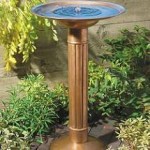North Carolina scientists indicate how water based ‘artificial leaf’ produces electricity
Guest Submission by Colleen J. Mcguire
 Are you aware that a North Carolina State University staff indicated that water gel-based solar devices (called: “artificial leaves”) can behave like solar cells to create electricity?
Are you aware that a North Carolina State University staff indicated that water gel-based solar devices (called: “artificial leaves”) can behave like solar cells to create electricity?
The analysis has been published on-line within the Journal of Materials Chemistry by Dr. Orlin Velev, an Invista Professor associated with Chemical and Bio-molecular Engineering.
The conclusions prove the concept for making solar cells that more closely copy nature. They also have the opportunity to be more affordable and more green than the present standard silicon based solar cells.
The bendable units are composed of water-based gel infused using light-sensitive molecules (like plant chlorophyll) coupled with electrodes coated by carbon materials, such as carbon nanotubes or graphite.
Graphene is the fundamental structural element of a number of carbon allotropes including graphite, carbon nanotubes and fullerenes. Graphene is a 1-atom thick planar sheet of carbon atoms that are largely packed in a honeycomb crystal lattice. The title comes from graphite ene; graphite itself consists of many graphene sheets stacked together.
The light-sensitive molecules get “excited” by the sun’s rays to create electricity, similar to plant molecules that get excited to synthesize sugars in order to grow.
Dr. Velev says that the analysis team hopes to be able to “learn how to copy the materials where nature harnesses solar energy.” Although manufactured light-sensitive molecules can be used, Velev says naturally produced products, like chlorophyll, are also very easily integrated in these units because of their particular water-gel matrix.
Velev even imagines a future where roofs could be covered with soft sheets of similar electricity-generating artificial-leaf solar cells. The concept of biologically inspired ‘soft’ devices for generating electricity may in the future present an alternative for the present-day solid-state technologies.
 About the Author: Colleen Mcguire produces for the <a href=”http://www.solarwaterfountains.org/”>solar fountains for the garden</a> blog, her personal hobby web log focused on guidelines to help home owners to spend a smaller amount energy with solar power.
About the Author: Colleen Mcguire produces for the <a href=”http://www.solarwaterfountains.org/”>solar fountains for the garden</a> blog, her personal hobby web log focused on guidelines to help home owners to spend a smaller amount energy with solar power.
Reference: Aqueous soft matter based photovoltaic or pv devices. Journal of Materials Chemistry, 2011; DOI: http://pubs.rsc.org/en/Content/ArticleLanding/2011/JM/c0jm01820a










